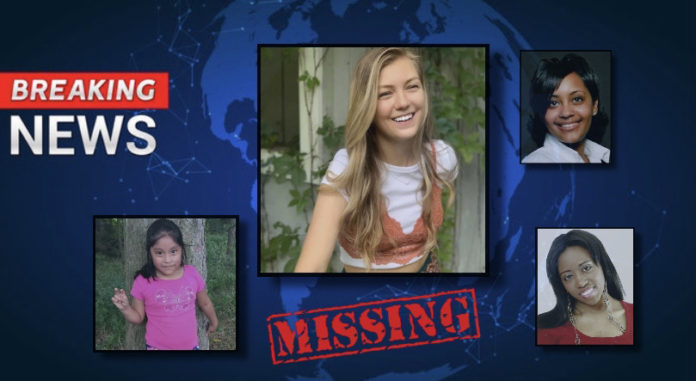Dulce Maria Alavez. Tamika Huston. Akia Eggleston. These are names you’ve probably never heard of before, but they are missing persons of color and victims of horrific crimes. Alavez, just five years old, vanished from a New Jersey park and is suspected to have been snatched by a child predator. Huston was murdered by a former boyfriend who was caught over a year later. Eggleston vanished over four years ago and still has not been found. None of these cases made national headlines, and even local reports were scarce. All across the country, hundreds of thousands of similar missing persons cases are reported every year, nearly half of which involve people of color as victims.
Meanwhile, people from Washington to Florida are talking about the recent murder of 22-year-old Gabby Petito. Anyone who has tuned into their favorite news channel, picked up a newspaper or scrolled through social media pages has probably heard her name. The media coverage Petito has received far eclipses that of hundreds of missing people of color.
“Missing white woman syndrome” was coined at the 2004 Unity: Journalists of Color conference to describe the disproportionate representation of media coverage in which missing white females get a lot more attention. As the term’s creator, Gwen Ifill, jokingly put it, “If there’s a missing white woman, we’re gonna cover that every day.”
There are serious implications to the press’s lack of coverage of missing people of color. Mass media coverage puts pressure on law enforcement, increases resources for widespread searches and furthers citizen support and awareness. It becomes very difficult for criminals to escape under these circumstances. So when perpetrators are looking for a target for their next murder, they know that they will more likely be able to get away if the victim is a person of color.
Black people alone account for over a third of the missing persons cases in the FBI database, a huge discrepancy considering only 13 percent of the U.S. population is Black. Most families of missing persons take it upon themselves to try and spread the word, often seeing little success. There are thousands of devoted fathers, caring mothers and faithful partners campaigning for their loved ones, long after law enforcement has given up. They all serve to reinforce the importance of media coverage in an investigation.
Why does the media seem to only care for white women? News is a consumer product, one that media corporations want to be as appealing as possible in order to retain customers, grow their platform and make more money. In essence, it’s all about the audience.
“We produced a report called ‘Normalizing Injustice’ … and actually talked to writers and producers; they felt like people would turn off the TV if the victim was a black woman,” Rashad Robinson, president of Color of Change, said.
Some say Petito’s case only garnered so much attention because Petito had a large social media following and frequently documented her life to share with others. Naturally, there would be more people already familiar with her and interested in getting justice for her murder. While this could be true, there is still a general trend that needs to be acknowledged. There are plenty of examples of pairs of missing persons cases where every factor aligns except race, and the contrast in media representation is striking. It makes it seem as if the lives of non-white people are valued less just because of skin color.
Moreover, the media often demonizes people of color. Stories about minorities often highlight negative aspects of their life, such as drug abuse, and insinuates that their disappearances are the consequence of their own actions.
There is a lesson to be learned here: we need to value different cultures, countries, and their people, and this goes for the institution of journalism as well. When it comes to people’s lives, the media should focus more on justice and the safety of missing persons rather than viewership.












